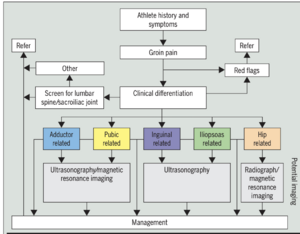Assessment of Athletes with Groin Pain: Difference between revisions
No edit summary |
No edit summary |
||
| Line 43: | Line 43: | ||
A groin examination classification system adapted using both the Warwick Agreement[ref] and the Doha meeting [ref] taken from Thorborg et al.(2018) | A groin examination classification system adapted using both the Warwick Agreement[ref] and the Doha meeting [ref] taken from Thorborg et al.(2018) | ||
[[File:Groin pain examination classification.png|left|thumb|[[:File:Groin pain examination classification.png|File:Groin pain examination classification.png]]]] | [[File:Groin pain examination classification.png|left|thumb|[[:File:Groin pain examination classification.png|File:Groin pain examination classification.png]]]] | ||
| Line 54: | Line 55: | ||
'''Adductor related groin pain''' | '''Adductor related groin pain''' | ||
Palpation of the adductor muscle group:{{#ev:youtube|IB_zBC3Hru0|300}} | Palpation of the adductor muscle group: | ||
{{#ev:youtube|IB_zBC3Hru0|300}} | |||
<ref>Accessed from https://www.youtube.com/watch?v=IB_zBC3Hru0 on 18/11/2021</ref> | <ref>Accessed from https://www.youtube.com/watch?v=IB_zBC3Hru0 on 18/11/2021</ref> | ||
| Line 65: | Line 68: | ||
Palpation of the iliopsoas muscle: | Palpation of the iliopsoas muscle: | ||
{{#ev:youtube|dpQhV-pCG3Q|300}} | {{#ev:youtube|dpQhV-pCG3Q|300}} | ||
| Line 70: | Line 74: | ||
Resisted hip flexion test: | Resisted hip flexion test: | ||
{{#ev:youtube|O_-Oi5uGU6I|300}} | {{#ev:youtube|O_-Oi5uGU6I|300}} | ||
<ref>[https://www.youtube.com/watch?v=O_-Oi5uGU6I Accessed] from https://www.youtube.com/watch?v=O_-Oi5uGU6I on 18/11/2021</ref> | |||
'''Inguinal related groin pain''' | |||
Palpation of the inguinal ligament: | |||
{{#ev:youtube|wDhtm2m3lT4|300}} | |||
Revision as of 17:40, 18 November 2021
Original Editor - User Name
Top Contributors - Prince Wilson
Introduction[edit | edit source]
Groin pain including Groin strains are common among athletes who participate in sports with repetitive and forceful hip movement [ref] Ice hockey and various football codes have been identified as sports with high prevalence of groin injuries due to the high intensity nature [ref]. Groin injuries accounts for 14 - 19% of all injuries in male football clubs and 2 - 14% in women. [ref]
Groin pain is typically thought of as difficult to diagnose and manage[ref]. In a systematic review on the treatment of groin pain, 33 different diagnostic terms were used to describe groin pain.[ref] The poor understanding of underlying pathology and structural attachment has created confusion regarding diagnosis and terminologies [ref]. The current understanding of hip joint pathologies which causes groin pain adds up to the complexities surrounding the diagnosis of groin pain.[ref]
However, in November 2014, an agreement meeting was held in Doha, Qatar involving experts in sports medicine. The Doha agreement meeting on terminology and definitions of Groin pain in athletes was held to address the problem. [ref]
Assessment[edit | edit source]
The Doha agreement agreed on three (3) subheadings for classifying groin pain of athletes. [ref]
- Defined clinical entities for groin pain:
- Adductor-related
- Iliopsoas-related
- Inguinal-related
- Pubic-related groin pain
- Hip-related groin pain
- Other causes of groin pain in athletes
Thorborg et al. (2018) provided a clinical framework for examination of athletes with Groin pain. The framework provides a comprehensive examination of the entire groin and hip joint region of an athlete with Groin pain. When serious pathology has been ruled out, the diagnosis can be made with focal findings on examination using the guidelines from the Doha agreement to classify the injury into 1 of the 4 clinical entities[ref]
Subjective Assessment[edit | edit source]
- Location of pain: The location of pain is essential in identifying the structures involved and should be enquired from the patient. Groin pain felt more anteriorly is the thigh region indicative of the iliopsoas related groin pain. Pain located more to the proximal inner thigh is indicative of adductor related groin pain.
- Injury mechanism: change of direction, kicking, reaching and jumping are the common actions associated with groin injuries. [ref]
- Acute or gradual onset: Groin pain can either be of an acute onset or gradual onset and knowing how the pain developed is important in both examination and management.
- Systemic symptoms: unexplained weight loss, fatigue, fever, painful urination and night pain should be treated with urgency and referred for further investigations.[ref]
Objective Assessment[edit | edit source]
A groin examination classification system adapted using both the Warwick Agreement[ref] and the Doha meeting [ref] taken from Thorborg et al.(2018)
Adductor related groin pain
Palpation of the adductor muscle group:
Adductor groin squeeze testing :
iliopsoas related groin pain
Palpation of the iliopsoas muscle:
Resisted hip flexion test:
Inguinal related groin pain
Palpation of the inguinal ligament:
References[edit | edit source]
- ↑ Accessed from https://www.youtube.com/watch?v=IB_zBC3Hru0 on 18/11/2021
- ↑ Accessed from https://www.youtube.com/watch?v=GwxrgZ_XgOU on 18/11/2021
- ↑ Accessed from https://www.youtube.com/watch?v=dpQhV-pCG3Q on 18/11/2021
- ↑ Accessed from https://www.youtube.com/watch?v=O_-Oi5uGU6I on 18/11/2021








